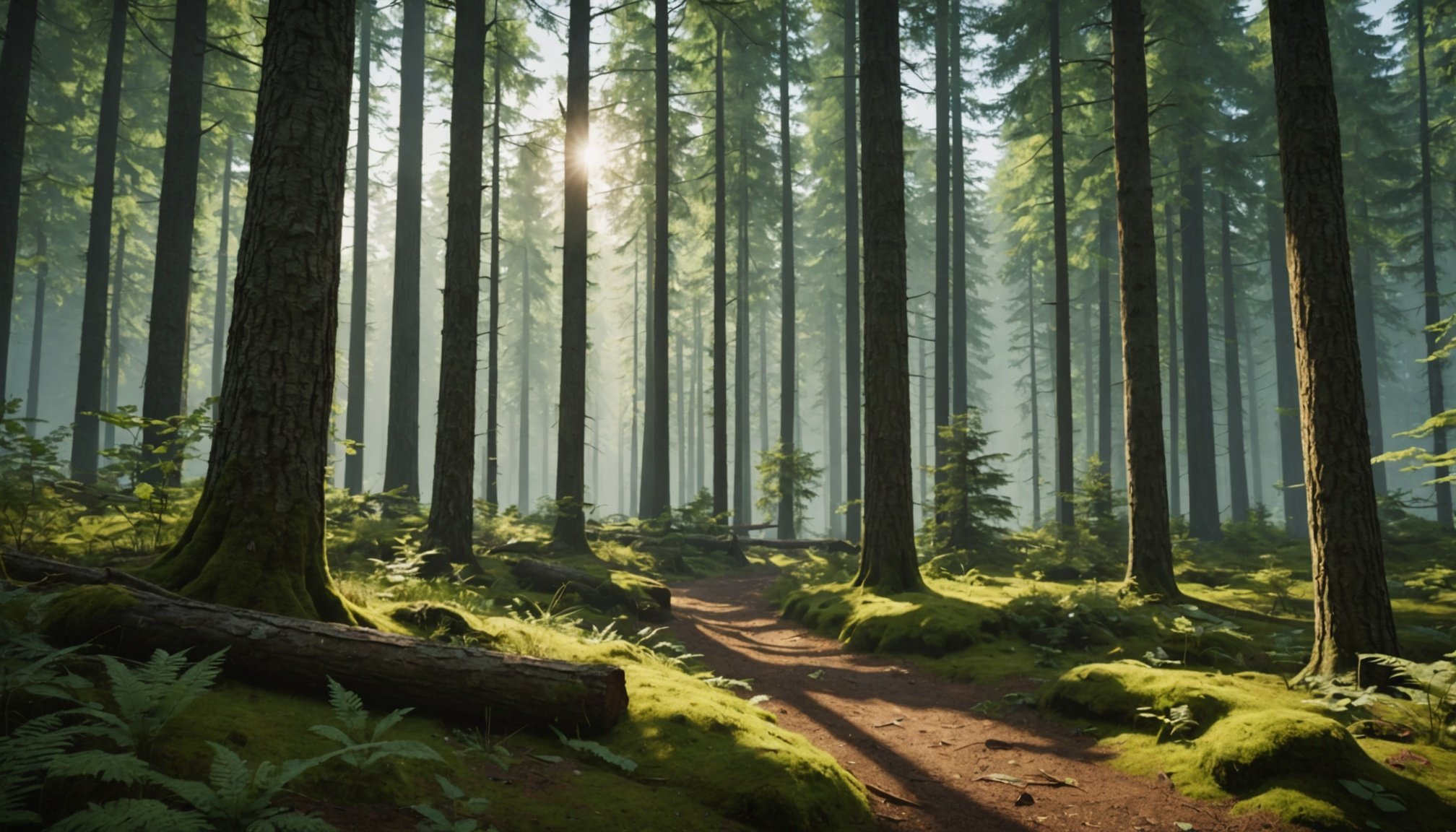Unlocking Lifelike Forests: Expert Strategies for Boosting Immersive Woodland Adventure Games
The Power of Immersion in Woodland Adventure Games
When it comes to creating an immersive woodland adventure game, the key lies in crafting an environment that feels alive and interactive. This is not just about visuals, but also about the depth of gameplay, the engagement of the players, and the overall experience that the game offers.
Learning Through Interaction
Games like Forest Shuffle: Woodland Edge exemplify how learning and development can be seamlessly integrated into gameplay. This expansion set introduces new flora and fauna, enhancing strategic play with lush edge-of-the-forest habitats. Players encounter diverse wildlife, discover hidden pathways, and manage woodland resources, all of which contribute to a rich learning experience.
This might interest you : Navigating the Intricacies: Top Challenges in Developing Multiplayer Games for Next-Gen VR Platforms
“By introducing 36 new multifunctional cards, Forest Shuffle: Woodland Edge adds incredible diversity and fresh strategies to explore,” notes the game’s designer, Kosch. “This expansion is perfect for nature lovers and strategy enthusiasts alike, offering endless possibilities for exploration and adventure.”
Building a Realistic Ecosystem
To create a lifelike forest, it’s crucial to focus on the ecosystem’s intricacies. Here are some strategies to achieve this:
Also read : Revolutionizing VR Gaming Accessibility: The Power of Eye-Tracking Technology Unleashed
Detailed Ecosystem Mechanics
- Layering and Set Collection: Games that incorporate mechanisms like layering and set collection can mimic the complex interactions within a forest ecosystem. For example, Forest Shuffle uses these mechanics to allow players to build and manage their forest, ensuring that each card has multiple uses and contributes to the overall health of the ecosystem[1].
Incorporating Real-World Science
- Pollinators and Plants: Understanding the interdependence of pollinators and plants is vital. Summer camps like those at Connolly Ranch teach children about these relationships through hands-on activities such as pollinator hunts and planting wildflowers. Integrating such scientific knowledge into games can enhance their realism and educational value[2].
Exhibition of Natural Phenomena
- Seasonal Changes: Incorporating seasonal changes and natural phenomena, such as the summer solstice, can add depth to the game. For instance, a game session themed around the summer solstice could include activities like building solar ovens and exploring shadow art, making the game more engaging and educational[2].
Interactive and Engaging Gameplay
Interactive elements are essential for keeping players engaged and immersed in the game.
Multi-Use Cards and Open Drafting
- Game Mechanics: Mechanics like multi-use cards and open drafting in Forest Shuffle: Woodland Edge allow players to strategize and make decisions that impact the game in various ways. This interactivity keeps players engaged and invested in their forest’s development[1].
Digital Enhancements
- Virtual Environments: Digital games can leverage advanced graphics and sound design to create a more immersive experience. For example, Wild Woods on Steam uses vibrant graphics and an engaging soundtrack to transport players into a woodland world where they defend their home as brave little cats[4].
Health and Mental Health Benefits
Woodland adventure games can also have significant health and mental health benefits, especially for children.
Outdoor Inspiration
- Nature-Based Activities: Camps like Connolly Ranch emphasize the importance of nature-based activities for children’s development. These activities, such as hiking, animal care, and farm-to-table cooking, can be replicated in games to promote a connection with nature and improve mental health[2].
Stress Relief and Social Interaction
- Collaborative Gameplay: Games that encourage collaboration, such as Wild Woods, can help reduce stress and improve social skills. Playing with friends or family in a virtual woodland setting can be a fun and healthy way to spend time together.
Practical Insights and Actionable Advice
Here are some practical tips for game developers and enthusiasts looking to enhance their woodland adventure games:
Conduct Thorough Research
- Ecosystem Studies: Conduct thorough research on forest ecosystems to ensure that the game is accurate and realistic. Collaborate with environmental scientists and botanists to get detailed insights into the flora and fauna of different forest types.
Incorporate Educational Elements
- Learning Development: Integrate educational elements seamlessly into the gameplay. For example, teaching players about the importance of pollinators or the life cycle of trees can make the game both fun and educational.
Use Cutting-Edge Technology
- Advanced Graphics and Sound: Utilize cutting-edge technology to create vivid and immersive environments. High-quality graphics and sound design can make the game feel more lifelike and engaging.
Case Study: Connolly Ranch Summer Camp
Connolly Ranch Summer Camp is an excellent example of how immersive woodland adventures can be designed for real-world settings.
Session Themes
- Sunbeams & Shadows: The camp’s “Sunbeams & Shadows” session celebrates the summer solstice with activities like designing suncatchers, crafting sundials, and exploring shadow art. These themes can be adapted into game sessions to add a layer of realism and educational value[2].
Age-Specific Activities
- Junior Farmers to Stewards: The camp offers activities tailored to different age groups, from Junior Farmers (ages 3-5) to Stewards (ages 10-12). This approach ensures that each participant has a meaningful and engaging experience, a strategy that can also be applied to game design.
Comparative Analysis of Woodland Adventure Games
Here is a comparative table of some woodland adventure games, highlighting their key features and benefits:
| Game | Key Features | Benefits |
|---|---|---|
| Forest Shuffle: Woodland Edge | 36 new multifunctional cards, layering, set collection, open drafting | Enhances strategic play, realistic ecosystem mechanics, educational value |
| Wild Woods | Couch co-op, action, teamwork, woodland critters | Promotes social interaction, stress relief, immersive virtual environment |
| Humblewood: “The Adventure in the Wood” | Voice acting, roleplaying, immersive storytelling | Engaging narrative, interactive atmosphere, world-class storytelling |
| Connolly Ranch Summer Camp | Nature-based activities, farm-to-table cooking, animal care, seasonal themes | Promotes learning development, mental health benefits, social skills improvement |
Quotes and Anecdotes
-
“By venturing into the Alpine region with Forest Shuffle: Woodland Edge, players get to experience new species and tree types, enriching their gameplay and connection with nature,” says Kosch, the game’s designer[1].
-
“Our summer camp sessions are designed to ignite imagination, inspire growth, and foster lasting connections with the land and each other,” notes a spokesperson from Connolly Ranch. “It’s not just about learning; it’s about creating magical memories that last a lifetime”[2].
Long-Term Impact and Support Systems
Creating an immersive woodland adventure game is not a one-time task; it requires ongoing support and updates to keep the experience fresh and engaging.
Professional Development
- Continuous Updates: Regularly update the game with new content, such as new card sets or game mechanics, to keep players engaged. This could involve collaboration with environmental experts to ensure the updates are accurate and educational.
Community Engagement
- Player Feedback: Engage with the player community to gather feedback and suggestions. This helps in identifying areas for improvement and ensures that the game remains relevant and enjoyable over the years.
Health and Mental Health Support
- Wellness Initiatives: Incorporate wellness initiatives within the game, such as mindfulness exercises or stress-relief activities, to support players’ mental health. This can be particularly beneficial for young people who spend a significant amount of time gaming.
Creating an immersive woodland adventure game is a multifaceted task that requires a deep understanding of ecosystems, interactive gameplay mechanics, and the health benefits of nature-based activities. By integrating educational elements, using cutting-edge technology, and focusing on player engagement and well-being, game developers can craft experiences that are not only fun but also enriching and beneficial.
Whether you’re a game enthusiast, a developer, or simply someone who loves the outdoors, the strategies outlined here can help you unlock the full potential of woodland adventure games, making them a joy to play and a valuable learning experience. So, dive into the world of lifelike forests, and let the adventure begin










